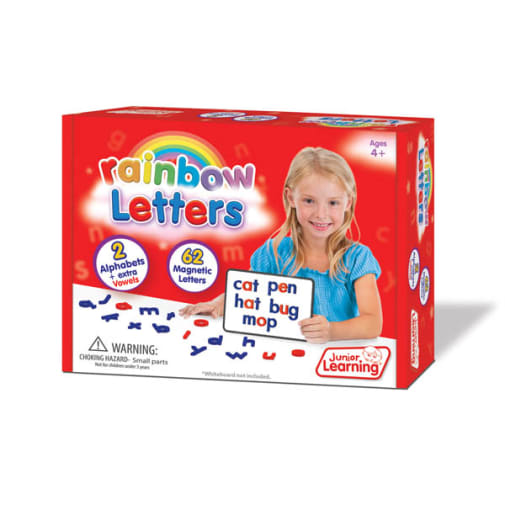These foam magnetic letters are easy for little ones to grasp and use. There are two sets of the alphabet with extra vowels (62 magnets total). Vowels are red and consonants are blue, making it easy for students to practice phonics. Children can place them on a whiteboard or any other magnetic surface to build and spell words.
Rainbow Magnetic Letters
SKU
071614
Grade PK-3
These icons are designed to help you quickly understand and learn important information about our products.
Teaching Method
Traditional
Teacher-centered curriculum commonly used in classrooms that may include a text, teacher manual, tests, etc.
Charlotte Mason
A methodology based on the work of a 19th century educator who maintained that children learn best from literature (Living Books), not textbooks.
Classical
A methodology based on the Latin Trivium (three stages of learning), including the grammar stage (memorization and facts), logic stage (critical thinking), and rhetoric stage (developing/defending ideas).
Unit Study
A thematic or topical approach centered around one topic that integrates multiple subject areas.
Montessori (Discovery)
A methodology based on the work of a 20th century educator that emphasizes student and sensory-driven discovery learning and real-life applications.
Other
Other methodologies
Religious Content
Secular
Contains content contrary to common Christian beliefs (i.e. evolution).
Neutral
Avoids religious or theoretical topics or presents multiple viewpoints without preference.
Christian/Religious
Faith-based or including instructional religious content.
Learning Modality
Auditory
Learns through listening, talking out loud or reading out loud.
Visual
Learns through seeing, prefers written instructions and visual materials.
Kinesthetic/Tactile (Hands-On)
Learns through moving, doing and touching.
Multi-Sensory
Curriculum that employ a variety of activities/components.
Presentation
Sequential
Curriculum progresses through well-defined learning objectives. Emphasizes mastery before moving to the next topic.
Spiral
Topics and concepts are repeated from level to level, adding more depth at each pass and connecting with review.
Conceptual/Topical
Focus is on the “why,” often with a unifying concept as well as specific skills; coverage may be broader.
Teacher Involvement
Low Teacher Involvement
Student-led materials; parent acts as a facilitator.
Medium Teacher Involvement
A mix of teacher-led time and independent student work.
High Teacher Involvement
Teacher-led lessons; may utilize discussions, hands-on activities and working together.
Additional Materials Required
No other materials needed
Everything you need is included.
Other Materials Required
There are additional required resources that are a separate purchase.
Other Materials Optional
There are additional resources mentioned or recommended but are not absolutely necessary.
Consumable
Consumable
Designed to be written in; not reusable.
Non-Consumable
Not designed to be written in; reusable.
Our Price
$9.99 $9.99 $8.50
Rainbow Savings: $1.49
Product Overview
- Set of 62 magnetic foam print letters
- Red consonants and blue vowels help children differentiate
- Lower case “a” is 1 inch tall
Warning
Choking Hazard
- Small parts. Not for children under 3 years.
Description
Publisher's Description of Rainbow Magnetic Letters
Rainbow Letters are a set of magnetic letters in a box. Includes 2 sets of the alphabet and an extra 2 sets of vowels. Vowels are color-coded in red and consonants are colour-coded in blue. Perfect for building CVC words or completing alphabet arc activities.
Category Description for Rainbow Phonics Magnetic Letters
Colorful. Multi-sensory. Systematic. Fun! At the heart are soft foam, color-coded magnetic letters (lowercase "a" is 1" tall). Consonants are blue, vowels are red, digraphs are yellow, vowel combinations are green. Available in partial sets in either cursive or print, and in a cursive set that includes an easel/magnetic board box with a chart for weekly letter introduction.
Details
| Product Format: | Other |
|---|---|
| Grades: | PK-3 |
| Brand: | Junior Learning |
| EAN/UPC: | 858136006874 |
| Length in Inches: | 4.375 |
| Width in Inches: | 5.875 |
| Height in Inches: | 1.75 |
| Weight in Pounds: | 0.2125 |
Videos
Reviews

